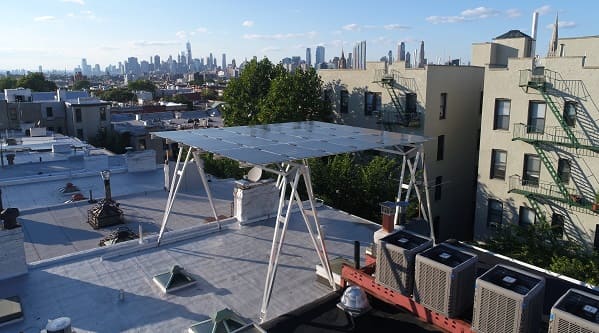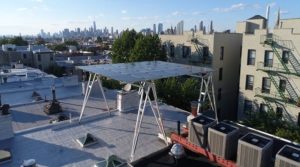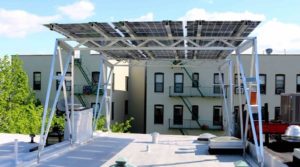New York solar canopies overcome challenges to renewable energy


The Big Apple presents difficult challenges to developing solar. Unlike the angled roofs of suburban homes, the city’s multifamily rooftops are overwhelmingly flat. In addition, building codes require at least a six-feet-wide and nine-feet-high unrestricted path. This drastically restricts the possible roof area available for panels. One company, Brooklyn SolarWorks, has developed a technical solution to this problem. It has already installed its unusual version of the solar array on several Brooklyn rooftops and will be rolling it out on nearly two-dozen low-income housing buildings over the next several years.
“New York City, and particularly Brooklyn, is a flat roof city with significant regulatory, zoning and code restrictions that limit solar possibilities on many roofs,” said Chris Neidl, Brooklyn SolarWorks’ Director of Business Development. “The city’s fire code in particular imposes significant restrictions in the form of clear paths and setbacks. One-to-four-family row homes and small commercial properties are most adversely affected.”
The solution the company came up with is called a “solar canopy.” The design places panels on top of aluminum “stilts,” with the stilts bolted securely to the roof and the panels themselves positioned ten feet above it. The time-lapse video below shows the process of installing a solar canopy.
Neidl estimates that this adds an average of between 50 to 100 percent more area to the solar panels, and thus more potential power. This method also leaves almost the entire roof area unimpeded, offering the additional advantage of allowing the panels to be tilted at an appropriate angle to the sun.
The design is modular and can be adapted to all kinds of roof surfaces. The canopy can also provide shade from the sun and shelter from rain, making it a convenient space for social gatherings of apartment residents. As for cost, the company works with several loan providers, such as Green Jobs-Green New York and GreenSky, to allow homeowners to purchase systems at little or no upfront cost.

One recent customer excited about solar canopies is the affordable housing nonprofit Fifth Avenue Committee (FAC), which collaborated with another local organization, Community Grid & Electric (CGE), formerly known as Gowanus Grid & Electric LLC, to provide solar power for some of its small, multifamily Brooklyn dwellings. After receiving substantial grant funds, the organizations issued a Request for Proposal (RFP) for the project. When Brooklyn SolarWorks submitted its proposal, FAC was impressed by both the canopy design and the organization’s commitment to hire and train people from the local workforce. Brooklyn SolarWorks will design installations for 21 of FAC’s 45 buildings.
To get the city’s approval for a solar installation on an apartment building can require, according to one source, 60 pages of paperwork. “It’s best to design around the fire code and master the details, rather than complain and try and change them,” said Neidl. “That’s been our approach, and the canopy is the most emblematic part of our business in that regard.”
Kedin Kilgore is founder and principal of CGE, and lead developer for FAC Solar, a partnership of CGE and FAC. “Brooklyn Solar Works can provide more solar for our solar roofs with innovative designs,” Kilgore said. “But, more importantly, they are willing to work with us to figure out how to make residential solar work on multi-family, affordable housing.”
